|
De 1429 and 511
|

|

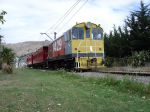
|

|
De 511 and 1429 are two of a class of fifteen locomotives built by the English Electric Company of the United Kingdom and two of seven DE class locomotives preserved in New Zealand. They were introduced onto the New Zealand Railways in 1951-2, becoming their first diesel-electric locomotives. The class was built for shunting and transfer work but were also used on suburban passenger trains and a number of the class, running in pairs, were used on the 1953 Royal Tour.
The class were powered by the English Electric 6SRKT Mk 1 diesel engine, a 6 cylinder inline engine with bore 10" and stroke 12", producing 660 hp at 750 rpm. They had a Bo-Bo wheel arrangement with four traction motors. The locomotives are of the hood type with a cab at one end. The class was not fitted with dynamic braking or the "vigilance" safety system that most other locomotives and multiple units have in NZ, and were not equipped for multiple-unit operation.
In latter years the locomotives reverted to their originally intended function of shunting and transfer and were dispersed to various parts of the country including Dunedin and Invercargill in the South Island.
De 511 was overhauled at Dunedin's Hillside Workshops about 1981/2 and was fitted at that time with a DG-type engine (6SRKT MkII) producing up to 750 hp, and placed in service in Dunedin with several other locomotives of the class. They continued there until 1987 when the Dunedin locomotives were withdrawn from service and written off the books. About a week before retirement De 1412 as it was now known, was run on a special excursion train from Dunedin to Wingatui, a distance of 12 km. The De class continued to operate in Invercargill until mid 1989 when the remaining locomotives there were withdrawn from service.
The week after being withdrawn, De 1412 along with De 1429 and other locomotives, was put up for auction at Hillside Workshops and both were purchased by the Diesel Traction Group as private shareholdings. The locomotives were then towed to Christchurch and subsequently transferred to the Ferrymead Railway.
De 1429 was overhauled at East Town Shops (Wanganui) in 1980 where it became the first of the class to be fitted with a Mark II engine from a Dg class loco. New cab side windows were also installed in a "modernisation". TMS colours were applied and it worked some months around Wellington on trials before transfer to the South Island in August 1981. It was sold to the DTG in 1987 after its withdrawal from NZR service and transferred to the Ferrymead Railway soon after.
The locomotive is painted in the original NZR TMS colour scheme and it carries its TMS number 1429. De 1429 is mainly used for heavy shunting and passenger service upon the Ferrymead Railway.
6 files, last one added on Feb 06, 2006
|
|
|
Dg 772
|

|

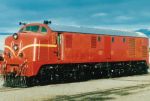
|

|
Dg 772 (TMS number 2255, formerly Dh 772) is the Diesel Traction Group's flagship locomotive. It is one of a class of forty-two locomotives that were built by the English Electric Company of the United Kingdom, in conjunction with the Vulcan Foundry and Robert Stephenson & Hawthorn Ltd. Introduced into NZ in 1955 as the Dg and Dh classes, they were the South Island's first diesel electric locomotives and added to several existing classes that were already at work in the North Island.
The Dg locomotives were powered by the English Electric 6SRKT Mk 2 diesel engine, a 6 cylinder inline with bore 10" and stroke 12", developing 750 hp at 850 rpm. The wheel arrangement was A1A-A1A with four traction motors mounted on the outer axles of each of the two three-axle bogies. Dg 772 was one of the first pair delivered to the South Island and was put to work in the Dunedin area after use as a stationary generator at Railway workshops.
In 1980 New Zealand Railways rebuilt ten of the class with new cabs and selected ten more unrebuilt locomotives to run as slaves (so that trains would be hauled by pairs of locomotives with the recabbed locomotive leading). Dg 2255 was one of the slave locomotives as were the other five which were initially set aside for preservation. By 1983 NZR had decided to withdraw the class completely and the ten slaves were all withdrawn from service by May. The recabs survived in operation until the end of 1980.
The Diesel Traction Group was formed in 1983 and Dg 2255 was selected for purchase, the money was put up as a private shareholding. The locomotive was then moved onto the Ferrymead Railway where it is still based.
In 1988, in conjunction with the Ferrymead 125 (Rail 125) celebrations, Dg 2255 was overhauled and certified to main-line running standard, repainted in its original colour scheme and renumbered to its original number, Dg 772.
1 files, last one added on Oct 04, 2005
|
|
|
Di 1820
|

|

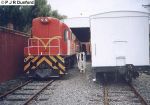
|

|
In 1966, New Zealand Railways purchased five Di locomotives from English Electric in Brisbane, Australia, as the possible prototypes of a class of lightweight locomotives for the South Island, however this role was eventually filled by the Dj class. The Di class was powered by an English Electric 6CSRKT diesel engine, 6 cylinder in line with bore 10" and stroke 12", producing 1012 hp at 850 rpm. The wheel arrangement was Co-Co with six traction motors, the first time this layout had been used in NZ. The Di class was generally similar to Queensland Railways' 1620 class.
The Di's have been used in a variety of roles in the NZR, in latter years mostly in secondary service and almost never in passenger service, except for the odd excursion. In their final days they were mostly used for shunting in the Wellington and Hawkes Bay areas. For some reason these locomotives were withdrawn several times and then immediately reinstated.
The Diesel Traction Group selected Di 1820 for preservation and she was transferred to the South Island in 1991, then on to the Ferrymead Railway.
1 files, last one added on Oct 04, 2005
|
|
|
|
Last additions - Diesel Traction Group Locomotives |

Feb 06, 2006
|
|
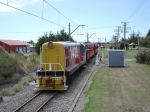
Feb 06, 2006
|
|
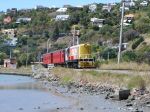
Feb 06, 2006
|
|

Jan 08, 2006
|
|
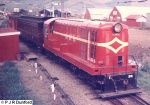
Oct 04, 2005
|
|

Oct 04, 2005
|
|
